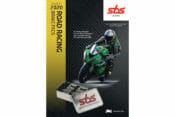2020 Suzuki Katana Review
There are few names in motorcycling with as much clout as “Katana.” We’ve spent the last couple of months with this new machine to find out if it lives up to the name.
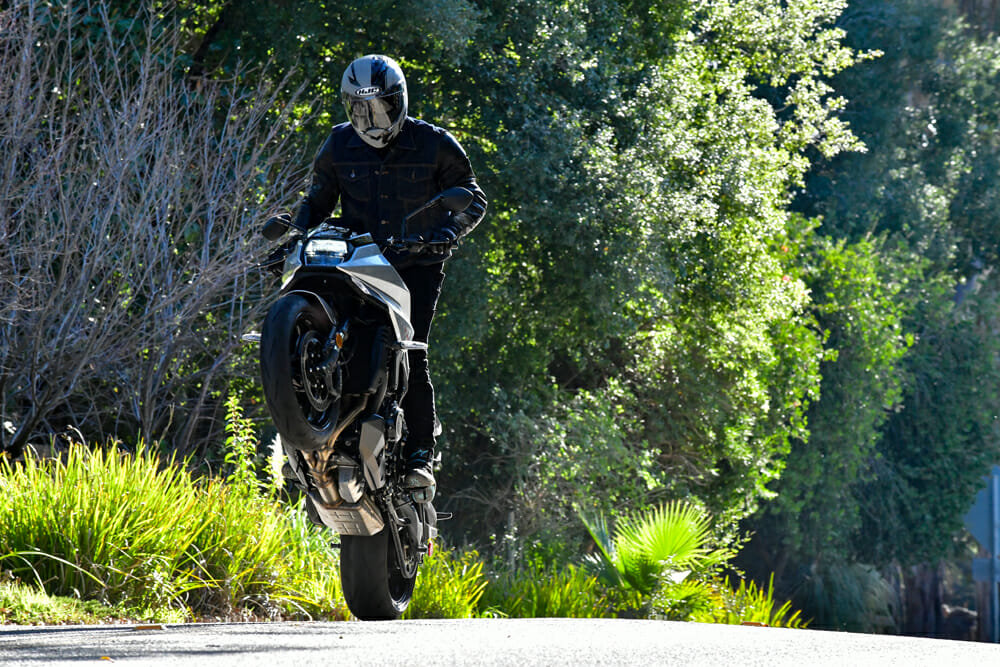
Photography by Kit Palmer
Reviving a name synonymous with a class-defining legend is a high-stakes game. If the model falls short of expectations, it can ruin a carefully built legacy at best, and cost a company massive dollars at worst.
We’ve seen this in the car game many times. Those who remember the butt-ugly Ford Mustang (it was really a Ford Capri) of the late 1980s can attest to the damage that model did to what is one of Ford’s greatest manufacturing exploits.
Reviving old monikers isn’t so common in the bike sphere—Kawasaki’s Z-range probably topping the old-bike-is-new game—but the Katana is something different.
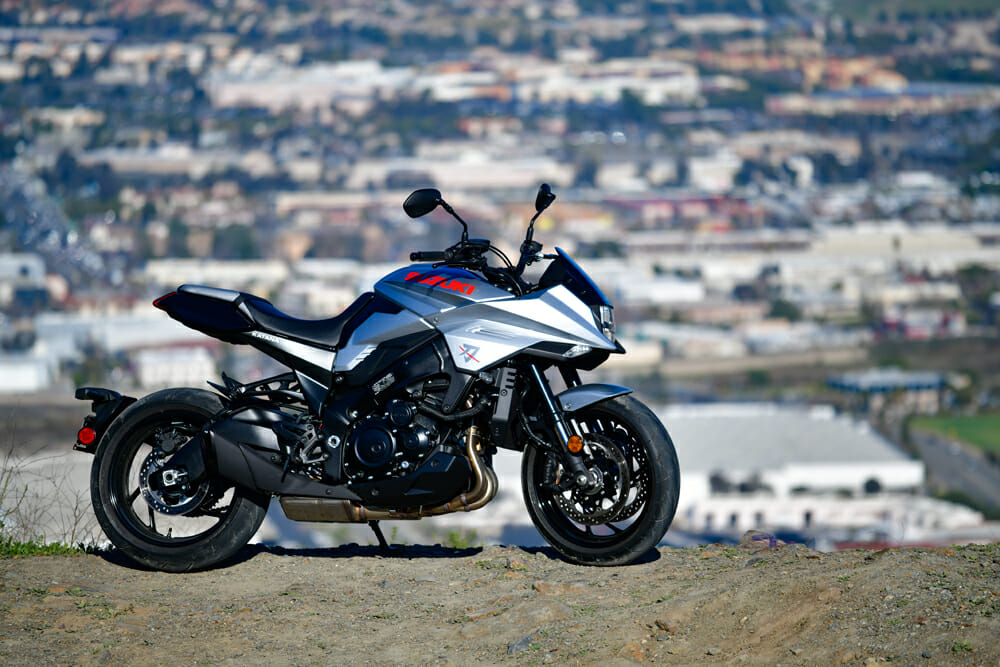
The 1981 Suzuki GSX 1100 S Katana is widely regarded as one of the greatest sportbikes of the 1980s, and was a prequel to one of the company’s all-time hits in the 1985 Suzuki GSX-R750. The Katana stunned the world with its 1980’s video game-style bodywork, all sharp and boxy-looking, and a performance that really announced Suzuki’s arrival into the 1980s—the decade that would redefine what a superbike should be with bikes like the GSX-R750, Yamaha FZR750R OW01 and Honda RC30 all released before the decade was out.
Eventually, the Katana became a diluted version of itself, with Suzuki trading off the once great name to release uninspired models like the 2006 GSX-F750 Katana—a porky, underpowered sport tourer that possessed none of the panache of its forefather.
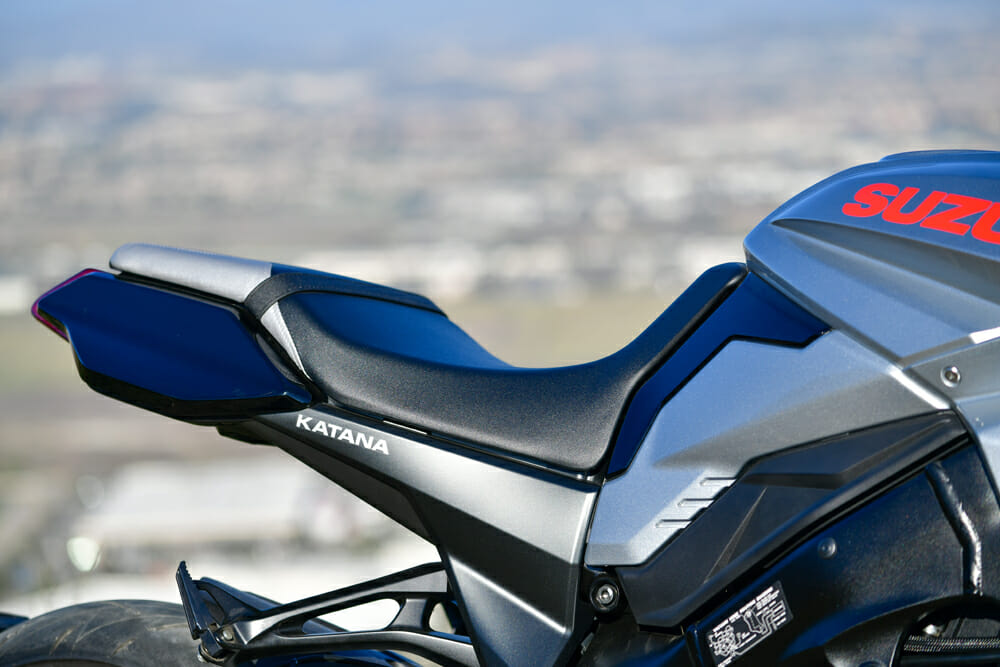
2020 Suzuki Katana Review | Step Forward, Son
It took Suzuki only a couple of years to go from design brief to full production model with the new Katana, and another year after the rest of the world for us to receive the model in the U.S.
Like many redo’s, the new Katana is not all new, as it’s based heavily off the GSX-S1000 that debuted in 2015—itself taking many of its parts from the 2005 Suzuki GSX-R1000.
The Kat gets the GSX-S’s same chassis, swingarm, and 43mm Showa front suspension (albeit with black fork legs instead of the GSX-S’s gold), as well as the same K5-derived motor. You can’t blame Suzuki for scavenging the 2005 parts bin here, as the K5 is widely regarded as one of Suzuki’s best-ever superbikes.
There’s a smattering of 2017 GSX-R1000 in the Kat’s makeup, too, with the four-piston Brembo, radially-mounted monobloc calipers up front and a single-piston Nissin caliper at the rear taken from Suzuki’s current superbike, although the Katana has no Inertial Measurement Unit fitted to molest brake performance. The brakes have plenty of power but a slightly wooden feeling at the lever, and mated to an un-switchable ABS system.
Without doubt, it’s the Katana’s styling that takes center stage. Suzuki’s engineers have done well to link this and the original, which after 40 years still looks the part (in my opinion). The new aesthetic is just a freshen up of the original, with the boxy front-end retained but the rear now a sleek, almost minimalist design with the number plate moved to its own separate hanger above the rear wheel—normally the domain of Harley-Davidson or Indian but a first for Suzuki.
The tank is one of the talking points. Suzuki tried to incorporate a design that stayed true to the original and wouldn’t be too high, and thus impede the rider’s arms with the tall one-piece handlebar, but big enough as to continue the line drawn from the small screen to the tail. The problem is the tank now holds only 3.2 gallons (the GSX-S1000S holds 4.5, and the OG Katana from 1981 held 6.3 gallons), meaning the new Katana won’t get you much further than about 110 miles of freeway cruising before you have to refill. If you get out in the hills and really go for it, you can drop that number to below 100 miles of range.
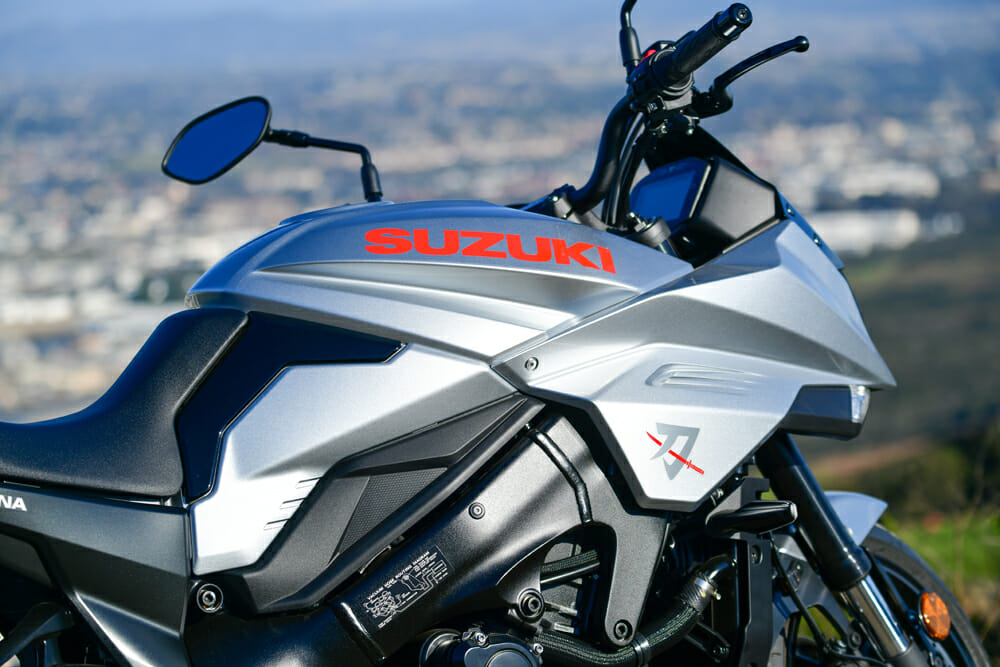
This becomes one of the Katana’s weak points, as almost all the modern retro’s in the market (Kawasaki Z900RS, Honda CB1000R, etc), will get you to 140 miles before needing a refill.
Another annoyance is the dash. With inspiration taken from the GSX-R1000, the 2020 Katana’s dash looks like it’s from its dad’s age. It’s difficult to read anything other than your speed or gear at a glance as you’re faced with too much information, all in the same Gameboy-level font, and the screen is almost impossible to read with the sun behind your back.
One of the good things within the Suzuki’s electronics package is that the three-level traction control system can be switched off and it will stay off after you’ve cycled the ignition. I’ll grant you this factor is only really handy if you want to get out there and throw some wheelies up, but it’s still a nice thing to have.
Another niceity is there are no ride modes to mess around with. Suzuki was the first to bring adjustable ride modes with the GSX-R range back in 2007 with the S-DMS (Suzuki Drive Mode Selector), but they have seen it fit not to grace the Katana with its presence.
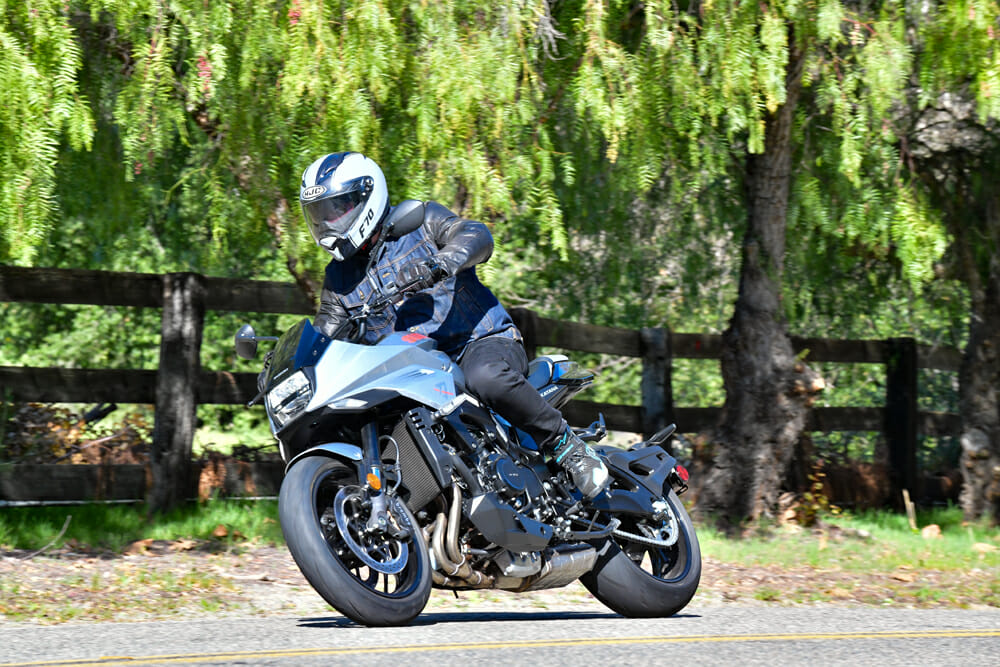
2020 Suzuki Katana Review | From the Saddle
All this adds up to an experience I’m not sure I was expecting. The ride position is extremely comfortable with the single-piece, high-rise handlebar putting no weight on your wrists, and the seat—although it doesn’t look it—is plush enough for long-ish days in the saddle (as long as you don’t mind filling up once or twice).
Suzuki USA quotes 147 horsepower out of their Katanas and it feels every bit that number. There’s more than ample power from the K5-derived motor, with an induction roar long gone from modern engine designs. It sounds mean, old-school, which is a good thing because modern four-cylinder engines don’t sound like this anymore.
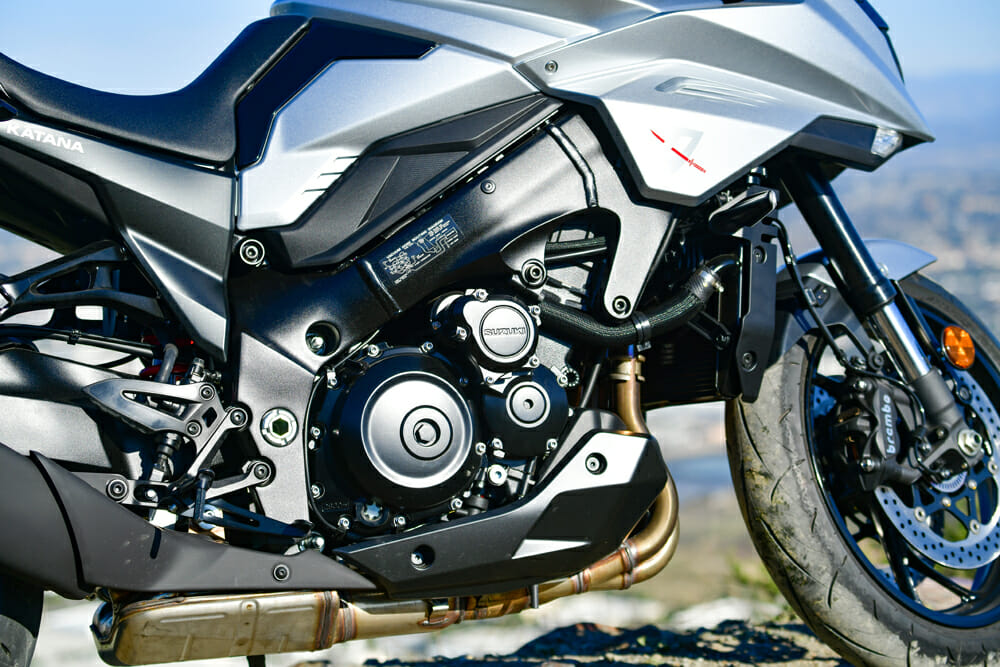
Midrange torque is plentiful, although the gearing feels a touch too short for my liking. Suzuki could have possibly stretched its legs a little further, as the engine has plenty of torque to handle it.
The throttle has a different cam profile at the twistgrip to the GSX-S, but herein lies a problem. Throttle response at low to mid openings and speeds is snatchy and jerky and not at all pleasant. Cutting through LA traffic at low speed is an exercise in throttle and clutch finesse, as just leaving it to rolling off and on makes the ride pretty uncomfortable.
Once the speed increases above 40-ish mph the throttle behavior improves dramatically—a good thing, considering how much fun this bike is in the medium speed twisties.
There’s no quickshifter on the Katana, and the gearshift is quite heavy compared to any modern hypernaked. It’s a direct feel, though, and you won’t miss a gear easily, but it’s again an old-school feeling compared to what’s out there in the market for a similar price.
As mentioned, the Katana is great fun in the twisties. The combination of a relaxed rider triangle, the K5 motor’s glorious torque and a nimble chassis makes for riotous fun when we tested this rig around Southern California’s canyons. The Katana isn’t going to trouble something like a Super Duke or a Tuono in the twisties, but then, it’s not really meant to. This a design from the past bought into the present, and makes for a unique riding experience.
The ride is a bit on the stiff side up front, and conversely, it’s soft at the rear, which can have the shock wallowing about when you first open the throttle. Trailing the rear brake will at least help everything remain somewhat settled when you’re really getting after it, and I suspect if you wanted a fancy little project bike and threw some decent suspension at the Katana, it’d really shine.
Front suspension action is good under heavy braking, but the initial turn-in isn’t as fluid as I’d have liked. Perhaps this is down to the fitment of the Dunlop Roadsport 2 tire as standard—this is a good tire but more towards long-mileage sport touring than canyon sport performance. Throw a set of either the Dunlop Sportmax Q3+ or even the more track-focused Q4 (a tire we’ve done lots of miles on and universally praise here at CN, at the Katana and this will make a big difference to initial turn speed and edge grip.
On the freeway, the Katana is pleasant enough, considering there’s almost no wind protection. That little screen does give you a bit of a reprieve from the wind blast, but this is no mile-muncher. The Katana is a weekend scratcher that can double as a decent commuter for some, but if you’re after long-haul comfort, look somewhere else.
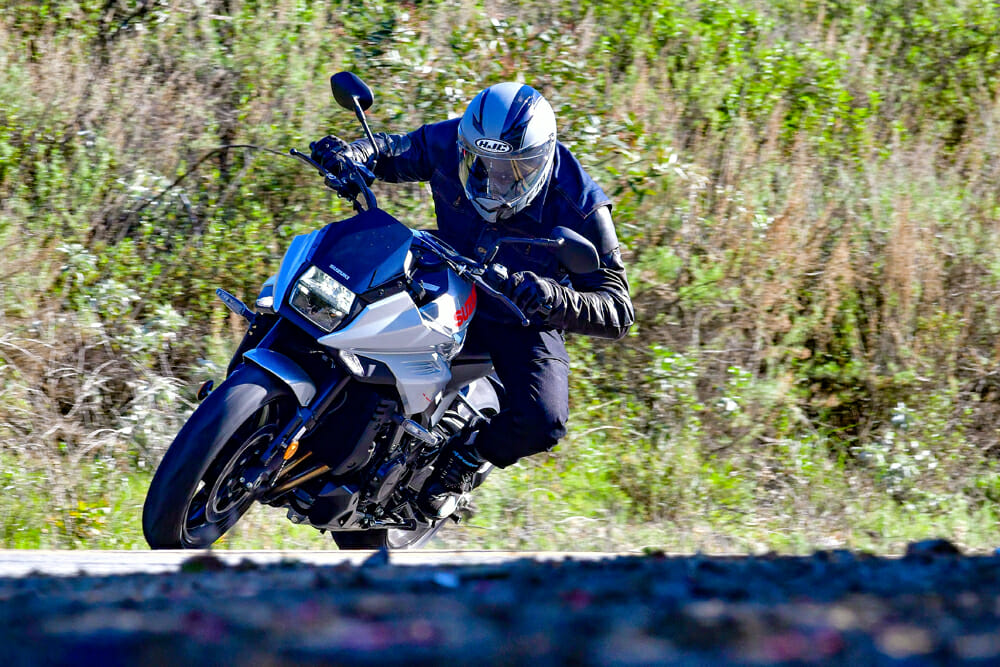
2020 Suzuki Katana Review | In the End
I’m glad the Suzuki Katana is back. I feel names like these should not be confined to the history books (I feel the same about the mighty Hayabusa), and Suzuki has done an admirable job of revitalizing a great brand from its past.
But, for me, the Katana falls short of topping the old-is-new retro bike class. The fuel mileage is extremely annoying (bringing the tank capacity up to four gallons would be a huge help); the lack of cruise control as even an available extra would have been great (granted other bikes in this space don’t have that feature but here was a chance for Suzuki to one-up them); the dash looks older than the K5-derived motor nestled in the chassis; the wooden feel at the brake lever is annoying and the snatchy low-speed throttle response all take a little away from the Katana’s joys. The overall design feels a bit rushed, and perhaps the two-year span from initial concept to production model should have been stretched a year longer.
The price is also up there. At $13,499 the Katana costs more than the stupendous $12,999 Yamaha MT-10 and Honda CB1000R, and the $11,199 Kawasaki Z900RS—the latter two of which are true competitors to the Katana—and I feel the fact so much of the Katana comes from 2015 and 2005 model bikes should give it a more competitive price point.
Design-wise, I think Suzuki nailed the look. I love 1980s bike designs so to see one so faithfully recreated by a company such as Suzuki is excellent.
The Katana will sell just because it’s a Katana, and fair enough. The ride is good, the looks are awesome, and it has one of the most legendary names in the history of motorcycling. But I was expecting more from this old-is-new legend.
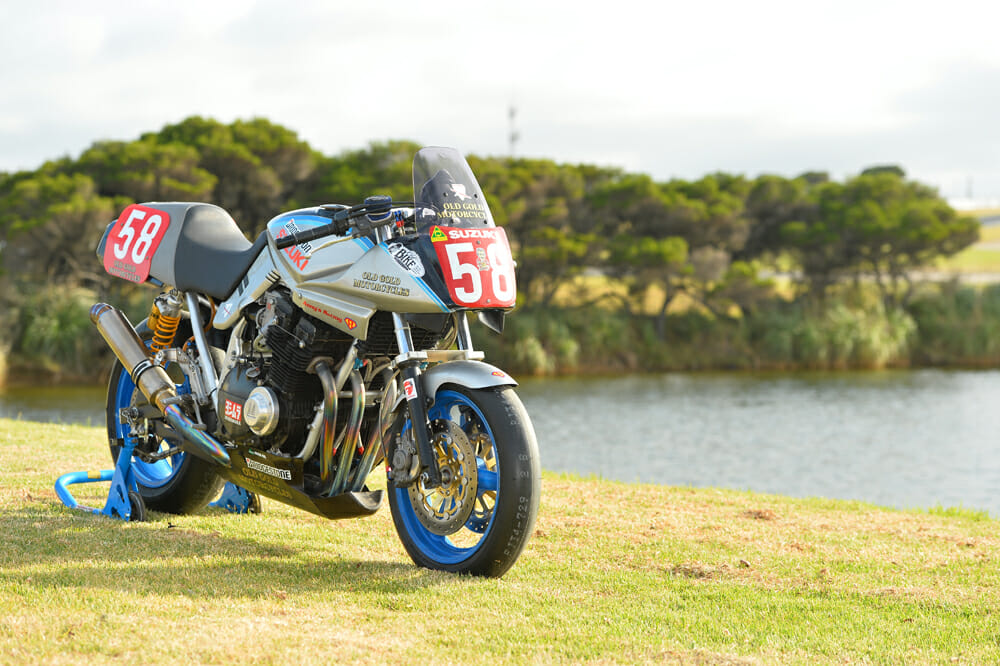
2020 Suzuki Katana Review | My Old Racer
I’ve ridden a few Katana’s in my time, but none have a place in my heart like the one I raced for a few years in Australia and most recently at the Island Classic for Team USA.
Based off a 1982 Katana 1100, the motor was bored out to a chunky 1290cc with 145 horsepower. It ran 37mm Keihin carburetors, had a welded crank, straight-cut gears, undercut gearbox, heavy-duty race clutch, a full titanium race exhaust system, and a Japanese Uotani ignition system.
As for the chassis, the bike was pretty tired with old Ӧhlins shocks at the rear and a cartridge fork kit. The standard swingarm was removed and we raced with a Macintosh unit and braced the frame, and we had Lockheed AP four-piston front brakes for the Island Classic.
Despite being up to 30 horsepower down on the competition, we managed a couple of top 15 results at the 2019 Classic against the likes of Josh Hayes, Jed Metcher and Isle of Man TT star, David Johnson. It was a great bike and is still being raced at selected events Down Under.
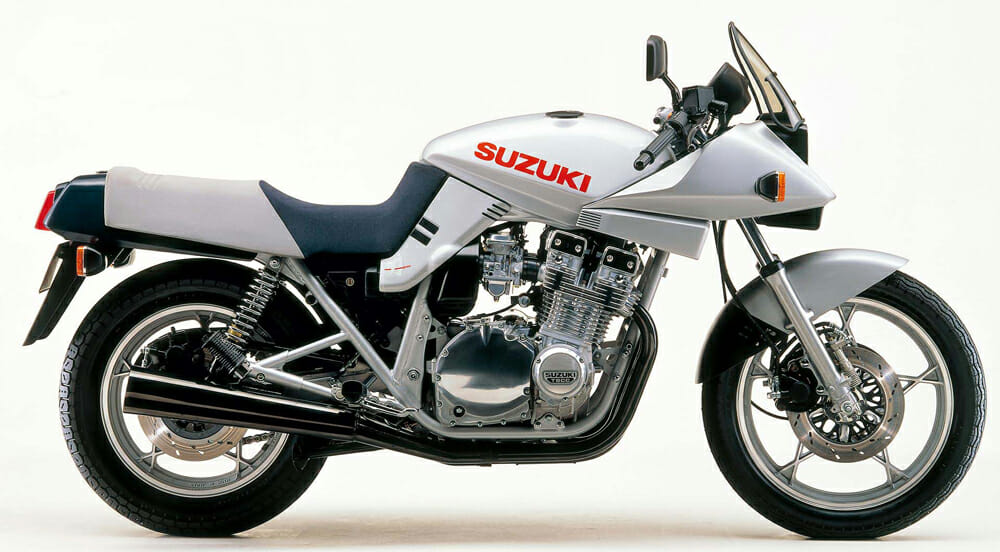
Then and Now
~Kit Palmer
I was barely 20 years old when I first laid eyes on the original Suzuki Katana in 1982. It was a magazine test bike and, still to this day, I vividly remember how out there I thought it looked.
I must admit, I also thought it was kind of, well…ugly. But at the same time super cool! Bottom line, though, I loved it. And it left a lasting impression on me.
So when Suzuki announced it was bringing it back, I was excited, and thrilled to see that Suzuki did a good job preserving that original Katana vibe nearly 40 years later.
The main thing I remember about riding the old Katana was how ridiculously uncomfortable it was because of its ultra-low seat and handlebars, and how you were forced to lay on the gas tank. The Katana designers back then obviously didn’t give rider comfort a second thought, or any kind of thought for that matter.
Luckily, today’s designers did give comfort a thought and made this one extra comfortable, fitting it with taller bars and a much better seat; no longer do you have lay on the tank. When it comes to riding the old Katana, that’s about all I remember, so it’s hard for me to compare it to the new one when it comes to performance.
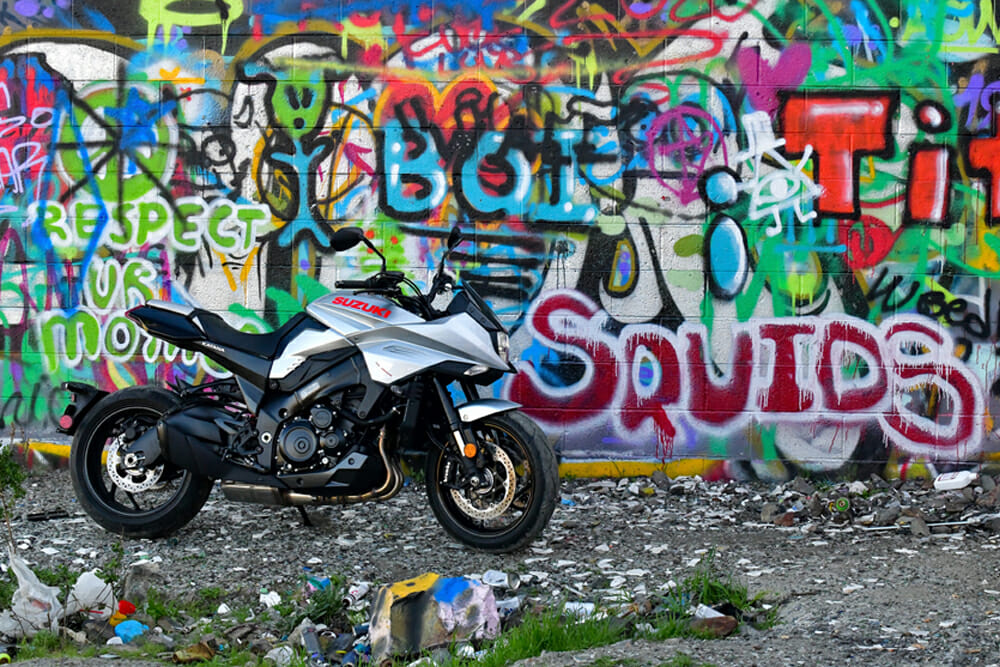
However, I can tell you that I enjoy riding the new Katana very much. The new one feels small, light and nimble. And it has plenty of motor for me. But perhaps what I like best about the motor is the way it sounds; it’s kind of loud, sounds aggressive and racy and makes you want to open ‘er up every time you run it through the gears. Now that I think about it, so did the old one!
Okay, so the new Katana isn’t the most refined motorcycle on the road, but neither was the old one (I remember that now, too), but that’s what I really like about the new Katana.
I don’t mind that throttle response is a little on/off, that the motor has an old-school feel, and that the dash looks like it came straight out of a Datsun B210. To me, that’s the appeal of the new Katana.
Still, I have gripes with the new one and they are, I must say, notable, a few of which Rennie has already touched on. I’ll reiterate; fuel range is awful and there is quite a bit you don’t get for a motorcycle that costs nearly $13,500. And, maybe it’s just me, but the steering stops could be wider.
Plus, the Katana might not be the best choice as a real-world everyday commuter, at least not for me, but this motorcycle isn’t about being practical. It’s more about having good simple fun and having a cool motorcycle at your disposal whenever the mood to blast up a nearby canyon road or ride downtown to your local taco shack on a warm sunny day strike. Sure, there might be other excellent motorcycles out there that can satisfy these moods just as well, too, and for less money, but they just aren’t a Katana.CN
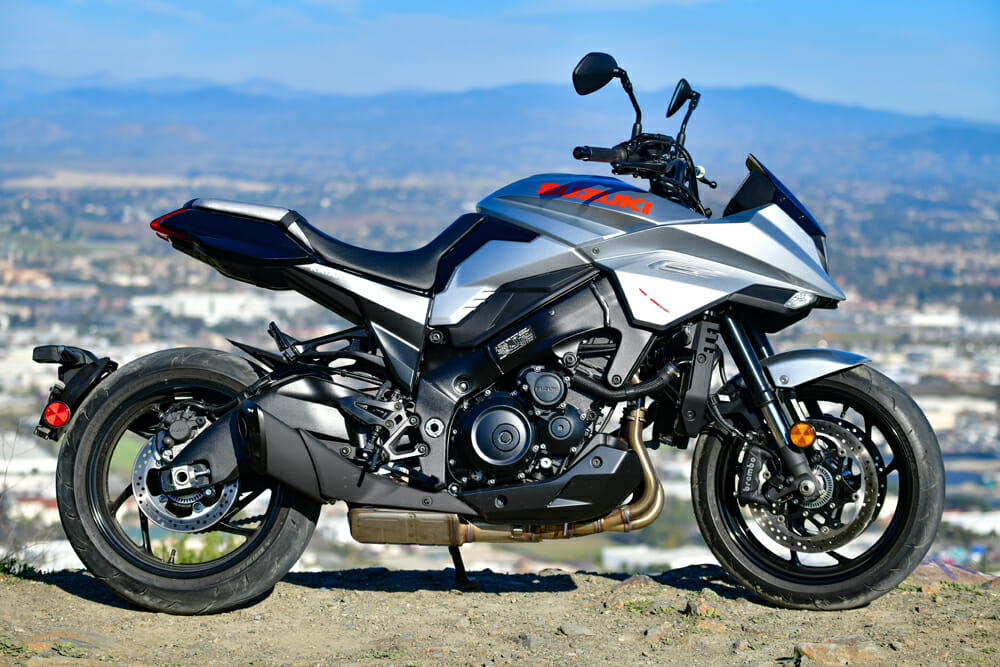
2020 Suzuki Katana Specifications
| MSRP: | $13,499 |
| Engine: | Liquid-cooled, 4-stroke, DOHC, inline 4 cylinder |
| Displacement: | 999cc |
| Bore x stroke: | 73.4 x 59mm |
| Compression ratio: | 12.2:1 |
| Fuel system: | EFI |
| Exhaust: | 4-2-1 |
| Transmission: | 6-speed |
| Chassis: | Aluminum twin-spar |
| Front suspension: | Showa 43mm inverted fork, fully adjustable |
| Rear suspension: | Showa monoshock, adjustable preload and rebound damping |
| Front-wheel travel: | 4.72 in. |
| Rear-wheel travel: | 5.12 in. |
| Front brake: | Brembo Monobloc 4-piston, radially mounted caliper, 320mm disc; ABS |
| Rear brake: | Brembo single-piston, fixed caliper, 240mm disc; ABS |
| Front tire: | 120/70ZR17M/C (58W) |
| Rear tire: | 190/55 ZR17M/C (73W) |
| Rake: | 25° |
| Trail: | 3.94 in. |
| Wheelbase: | 57.6 in. |
| Seat height: | 32.5 in. |
| Fuel capacity: | 3.2 gal. |
| Weight (claimed, curb): | 474 lbs. |
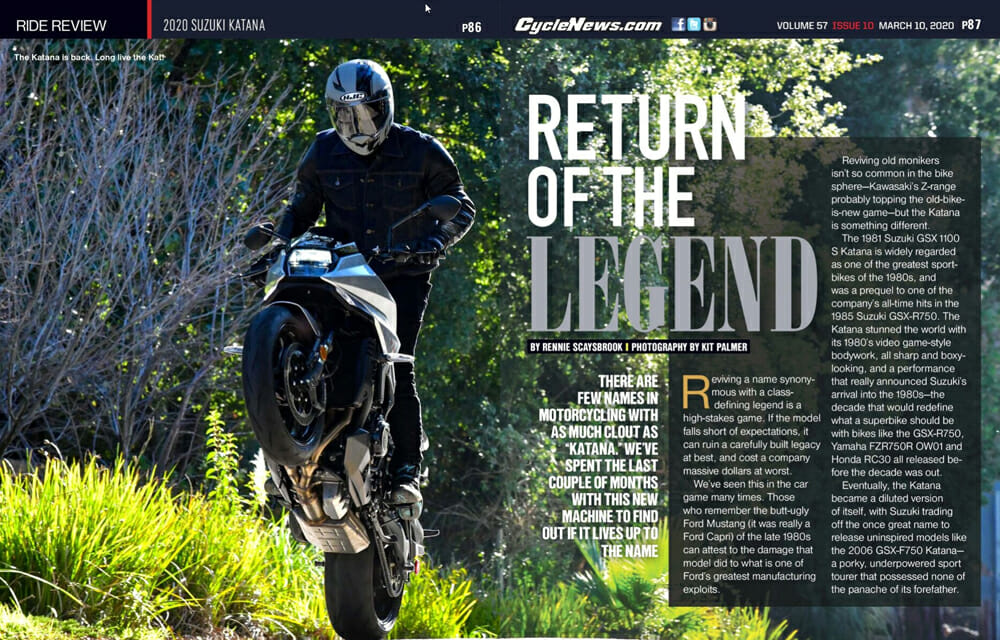
Click here to read this in the Cycle News Digital Edition Magazine.
Click here for the latest Cycle News Sportbike motorcycle reviews and news.
Click here for more Suzuki motorcycle reviews and news.
